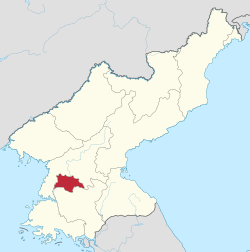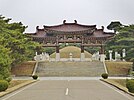
Back Pyeongyang ACE Pjongjang Afrikaans Pjöngjang ALS ፕዮንግያንግ Amharic Pyongyang AN Pīonganc ANG بيونغيانغ Arabic بيونغيانغ ARZ পিয়ং ইয়াং Assamese Pyong Yang AST
Pyongyang
평양시 | |
|---|---|
| Pyongyang Directly Governed City | |
| transcription(s) | |
| • Chosŏn'gŭl | 평양직할시 |
| • Hancha | 平壤直轄市 |
| • McCune–Reischauer | P'yŏngyang Chikhalsi |
| • Revised Romanization | Pyeongyang Jikhalsi |
| Nickname(s): | |
 Location of Pyongyang in North Korea | |
 Pyongyang highlighted in red in North Korea | |
| Coordinates: 39°01′00″N 125°44′51″E / 39.01667°N 125.74750°E | |
| Country | North Korea |
| Districts | 19 districts(or wards), 2 counties,1 neighbourhood
|
| Government | |
| • Type | Directly governed city |
| • Body | Pyongyang City People's Assembly |
| • Secretary of the City Committee | Kim Su-gil |
| • Chairman of the People's Committee | Choi Hee-tae |
| Area | |
| • Directly governed city | 829.1 km2 (320.1 sq mi) |
| • Metro | 3,194 km2 (1,233 sq mi) |
| Population (2021)[3] | |
| • Directly governed city | 3,157,538 |
| • Density | 3,800/km2 (9,900/sq mi) |
| Demonym | Pyongyangite(s)[4] |
| Time zone | UTC+09:00 (Pyongyang Time) |
| • Summer (DST) | (Not Observed) |
| ISO 3166 code | KP-01 |
| Pyongyang | |
 "Pyongyang" in Chosŏn'gŭl (top) and hancha (bottom) | |
| Korean name | |
|---|---|
| Chosŏn'gŭl | 평양 |
| Hancha | 平壤 |
| Revised Romanization | Pyeongyang |
| McCune–Reischauer | P'yŏngyang |
| lit. 'flat soil' | |
Pyongyang[a] (Korean: 평양; Hancha: 平壤) is the capital and largest city of North Korea, where it is sometimes labeled as the "Capital of the Revolution" (혁명의 수도).[8] Pyongyang is located on the Taedong River about 109 km (68 mi) upstream from its mouth on the Yellow Sea. According to the 2008 population census, it has a population of 3,255,288.[9] Pyongyang is a directly administered city (직할시; 直轄市; chikhalsi) with a status equal to that of the North Korean provinces.
Pyongyang is one of the oldest cities in Korea.[10] It was the capital of two ancient Korean kingdoms, Gojoseon and Goguryeo, and served as the secondary capital of Goryeo. Following the establishment of North Korea in 1948, Pyongyang became its de facto capital. The city was again devastated during the Korean War, but was quickly rebuilt after the war with Soviet assistance.
Pyongyang is the political, industrial and transport center of North Korea. It is estimated that 99% of those living in Pyongyang are members, candidate members, or dependents of members of the ruling Workers' Party of Korea (WPK).[11] It is home to North Korea's major government institutions, as well as the WPK which has its headquarters in the so-called Forbidden City.
- ^ Funabashi, Yoichi (2007). The Peninsula Question: A Chronicle of the Second Northern Korean Nuclear Crisis. Washington, DC: Brookings Institution Press. p. 50. ISBN 978-0-8157-3010-1.
- ^ Nick Heath-Brown (ed.). The Statesman's Yearbook 2016: The Politics, Cultures and Economies of the World. p. 720.
- ^ United Nations. "Democratic People's Republic of Korea". Data.un.org. Archived from the original on 28 November 2022. Retrieved 16 July 2023.
- ^ Specialties of Korea (PDF). Foreign Languages Publishing House. 2022. Archived (PDF) from the original on 12 January 2023. Retrieved 12 January 2023.
- ^ Wells, John C. (2008). Longman Pronunciation Dictionary (3rd ed.). Longman. ISBN 978-1-40588118-0.
- ^ "Pyongyang definition and meaning | Collins English Dictionary". Archived from the original on 7 June 2016. Retrieved 15 May 2023.
- ^ "Definition of P'YŎNGYANG". www.merriam-webster.com. Archived from the original on 12 May 2023. Retrieved 15 May 2023.
- ^ "「혁명의 수도」선포...금속·건재 공업이 주류". JoongAng Ilbo (in Korean). 3 July 1989. Archived from the original on 11 August 2022. Retrieved 11 August 2022.
- ^ D P R Korea, 2008 Population Census, National Report (PDF). Archived from the original (PDF) on 25 March 2009. Retrieved 17 February 2018.
- ^ Cite error: The named reference
EBPyongyangwas invoked but never defined (see the help page). - ^ Collins, Robert (2012). Marked for Life: Songbun, North Korea's Social Classification System (PDF). United States: Committee for Human Rights in North Korea. p. 69. ISBN 978-0985648008. LCCN 2012939299.
Cite error: There are <ref group=lower-alpha> tags or {{efn}} templates on this page, but the references will not show without a {{reflist|group=lower-alpha}} template or {{notelist}} template (see the help page).








